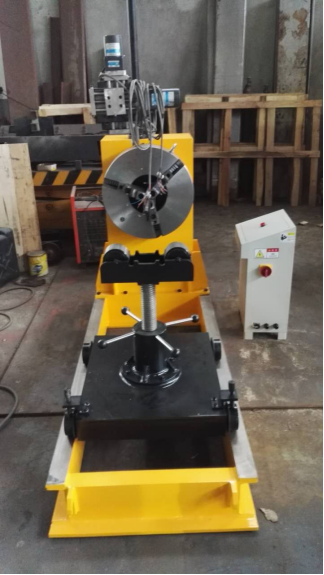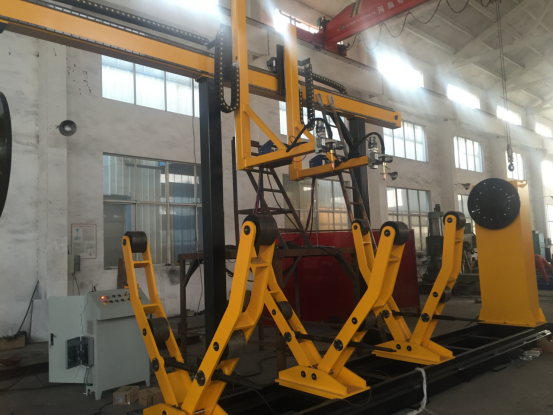In modern shipyards, welding processes account for over 35% of the total construction cycle. Traditional manual welding methods are not only inefficient but also struggle to ensure consistent quality in large hull structures. A case study from a leading shipbuilder in Jiangsu showed that without professional welding turntables, the rework rate for hull block welding remained at 15%, severely impacting delivery schedules and construction costs.
The introduction of welding positioning systems has revolutionized this scenario. These specialized devices, capable of 360-degree precision rotation, optimize weld positioning to achieve superior quality. At Shanghai Waigaoqiao Shipyard, implementing welding rotators increased the first-pass qualification rate for circumferential welds from 86% to 98.5%, reducing the welding cycle per vessel by 22 days.
New Standards for Hull Block Welding
Welding curved hull sections has always been a technical challenge in modern shipbuilding. Traditional methods require welders to perform overhead and vertical welds in confined spaces, leading to high labor intensity and inconsistent quality. For example, a 100,000-ton container ship project incurred nearly 3 million RMB in additional costs due to rework caused by insufficient penetration in overhead welds.
Heavy-duty welding positioners solve this problem. Their precise rotation and tilting functions ensure all welds are performed in the optimal flat position. Data from a Ningbo shipyard showed that using a 500kN-capacity welding manipulator improved hull block welding efficiency by 40% and reduced distortion by 65%, significantly decreasing post-weld correction work.

Precision Solutions for Piping Welding
Ship piping systems demand extremely high welding precision, especially for stainless steel pipes in LNG carriers, where minor deviations can have serious consequences. Manual welding often results in misalignment beyond tolerance limits, requiring repeated adjustments. A quality report from a Guangdong shipyard revealed a long-term rework rate of 20% for piping welds, severely hampering productivity.
Specialized pipe welding positioners, featuring hollow shaft designs and servo control systems, achieve alignment accuracy within 0.1mm. At Hudong-Zhonghua Shipyard’s LNG carrier project, these devices achieved a 99.3% first-pass qualification rate and tripled welding speeds, ensuring on-time delivery.
Precision Welding for Propulsion Systems
Critical propulsion components like propeller shafts and rudder stocks require near-perfect weld quality. Defects can compromise performance or even lead to catastrophic failures. Traditional methods struggle to ensure uniformity in large rotating parts.
High-precision CNC welding positioners address this challenge. With repeatability of 0.02° and synchronized control with welding power sources, they ensure consistent heat input around the circumference. At Dalian Shipbuilding Industry, these systems significantly improved weld quality stability, enabling certification from DNV GL and other classification societies.
Proven Return on Investment
A common concern among shipyard managers is whether investing in welding positioning equipment is justified. Financial data from a mid-sized Zhejiang shipyard provides a clear answer. After purchasing two heavy-duty welding manipulators for 1.8 million RMB, the shipyard saved 650,000 RMB in labor costs, reduced rework expenses by 480,000 RMB, and earned 300,000 RMB in bonuses for early delivery in the first year. More importantly, improved weld quality helped secure more high-end vessel orders, increasing annual output value by 25%.

The Future of Ship Welding Technology
As smart shipbuilding evolves, intelligent welding turntables are becoming more advanced. The latest models integrate seamlessly with welding robots, use IoT for real-time parameter monitoring, and leverage digital twin technology for process optimization. These innovations enhance quality and efficiency while building valuable process databases.
For shipyards considering upgrades, now is the ideal time. Professional welding positioning solution providers offer customized configurations, process optimization, and operator training. Through thorough communication and trial welding, shipyards can ensure the equipment perfectly matches their needs.
Welding is the core process in shipbuilding, directly determining vessel performance and longevity. Investing in professional welding positioning and manipulation systems is not just a solution to quality challenges—it’s a strategic move to enhance competitiveness and capture premium markets. In today’s era of high-quality shipbuilding, this is no longer optional but essential.
Keywords:
intelligent welding turntables,welding positioning, manipulation systems,pipe welding positioners
